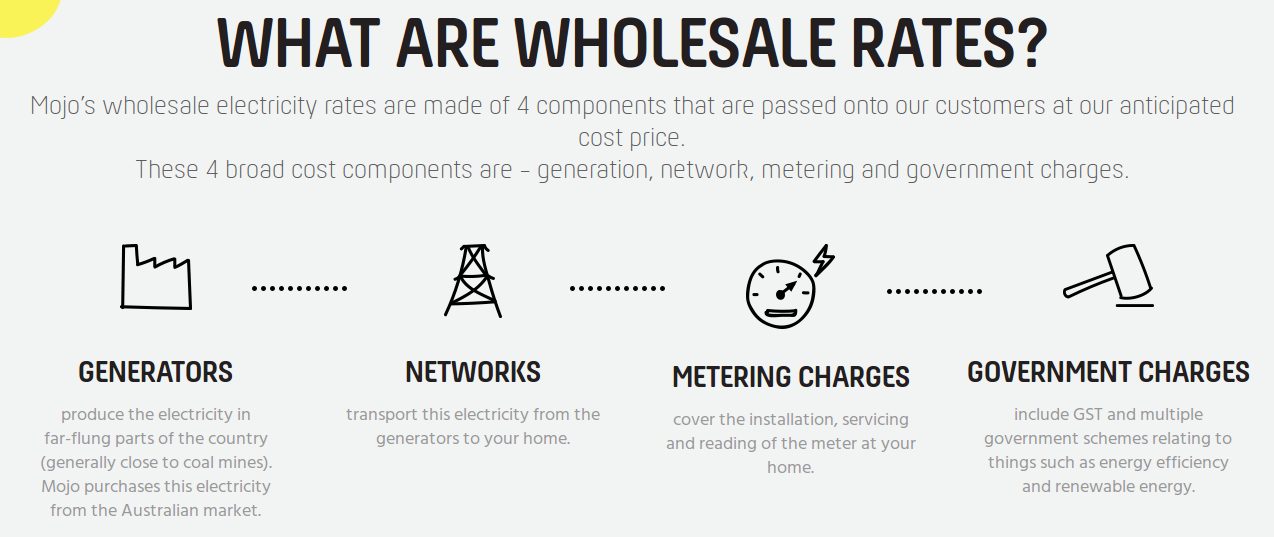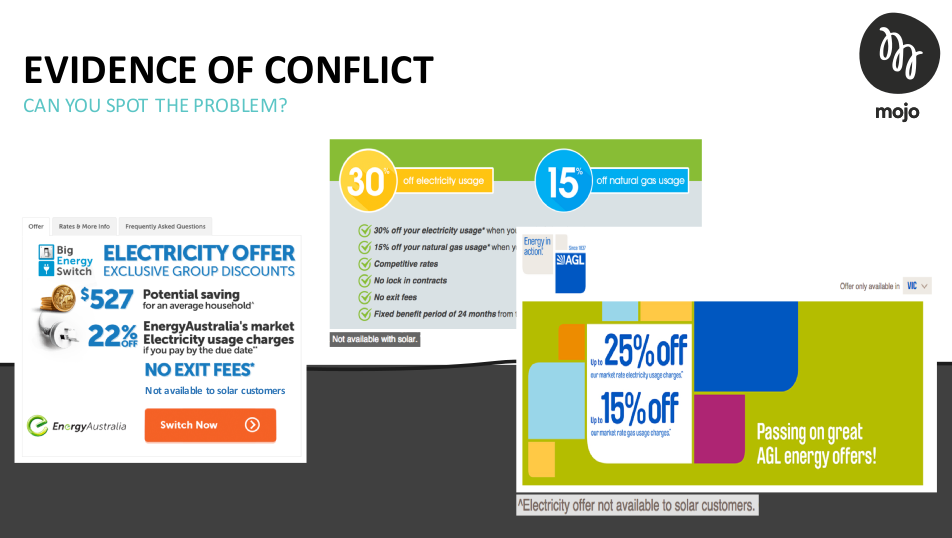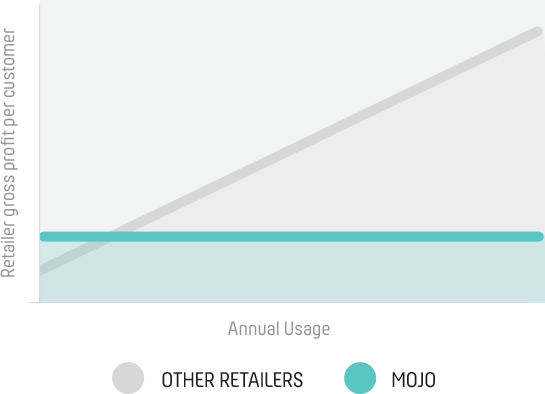Imagine if your electricity retailer did not see a profit when you use more electricity. How would your relationship be different?
While it may sound like a fantasy to an Australian populace which has come to view the retail electricity sector with a deep cynicism, one company – Mojo Power – claims to have found a way to circumvent the ‘user pays’ approach to billing which has characterised the electric utility business model since its inception nearly a century ago.
We are all familiar with the basic idea of how we are billed for electricity: the more we use, the higher our bills will be. In Australia, where many aspects of once public utilities have been largely deregulated, retailers make their money by marking up each kilowatt-hour (kWh) of electricity that you buy. Because each kWh consumed improves their margins, it is intrinsically in their best interest for customers to consume more energy. There are some fixed daily fees (which have been an issue of some controversy in their own right), but the largest component of most residential electricity bills is energy usage; this is also the component over which you have the greatest amount of direct control. Here’s where the conventional electricity retailer’s business model and the self-interest of energy-consuming homes collide, and where Mojo Power is looking to shake things up.
Decoupling customer consumption & corporate profits: The Mojo M.O.
Mojo Power differentiates itself from conventional retailers in a few different ways, all of which are related to their ‘no markup’ approach to electricity sales. The main ways in which Mojo is different are outlined below.
1. Mojo makes its money by charging a flat monthly subscription fee instead of markups on electricity consumption
Mojo has come up with a billing model that decouples customer energy consumption levels and Mojo’s profits. Instead of marking up the electricity that its customers use, Mojo sells their customers electricity ‘at cost’ and charges a monthly subscription fee. The subscription fee – called an ‘Energy Pass’ – is where the company makes its money.
A diagram explaining the relationship between customer energy consumption and corporate profits at a conventional retailer vs at Mojo Power.
2. Mojo’s wholesale rates are cheaper
Because it doesn’t mark up the electricity it sells, Mojo Power can deliver electricity at heavily discounted rates to all of its customers. Mojo’s wholesale rates are on average about 10-15% cheaper than other retailers. The company offers flat rate, time-of-use and controlled load tariffs at wholesale rates.
 An explanation of Mojo Power’s wholesale rates.
An explanation of Mojo Power’s wholesale rates.
3. Mojo does not discriminate against solar customers
For the most part, Australian electricity retailers are not the friends of solar-powered homes. Solar homes are precluded from signing up for many retailers’ best discounts.
 Screenshots from the websites of electricity retailers illustrating how solar customers are excluded from discounted plans. (Image via Mojo Power.)
Screenshots from the websites of electricity retailers illustrating how solar customers are excluded from discounted plans. (Image via Mojo Power.)
4. It’s in Mojo’s financial interest for you to save money
Mojo makes it clear that the ball is in their court to help their customers save money. Because their subscription fees are where they make their profits, a growing number of happy customers with smaller overall energy bills is what will keep them in business. The company says that rather than delivering a service, it works alongside its customers in a money-saving partnership.
4. Mojo gives you the technology & intelligence you need to reduce your consumption – and your bills
Another key feature of Mojo’s service is the installation of a high-tech smart meter which allows customers to see their electricity usage in real time and respond accordingly – instead of waiting for their monthly or quarterly electricity bill to pop out of an envelope and surprise them. (In fact, Mojo is also paperless, precluding the chance of such a thing happening at all).
The promotional video below neatly sums up the main benefits that Mojo offers its customers:
What does Mojo mean for solar homes?
These days, Australian homes invest in rooftop solar systems to save money – the more solar they self-consume, the less energy they need to purchase from the grid. For the run-of-the-mill energy retailer, households who use solar to cut their bills are therefore not ‘ideal customers’ – they deliver smaller profits compared to those without solar.
Furthermore, electricity retailers offer only a pittance for excess solar energy that homes export to the grid – only 6-8c/kWh vs the 20c/kWh+ that most Australians pay for grid power. This has long been a sore spot for Australia’s solar homes, who generally view these rates as grossly unfair – even while recognising that rooftop solar can still be worth the investment.
While Mojo doesn’t promise higher solar feed-in rates, the company does come onside with solar homeowners, giving them the insights and guidance that they need to get the most out of the solar that they generate. This could potentially help customers to save more money in total than by upping their feed-in rate – which would need to be in the order of 15-20c/kWh to start making a significant difference.
Want to learn more? Contact Mojo
Email: hello@mojopower.com.au
© 2016 Solar Choice Pty Ltd
- Solar Panel Costs: Solar Choice Price Index | April 2025 - 1 April, 2025
- Solar Panels For Homes – All You Need to Know About Solar Systems - 18 March, 2025
- Best NSW Solar Feed-In Tariffs - 17 March, 2025

I struggle to follow my account from Energy Australia with there supposed discounts. My last account from them I think shows I used on there Flexi saver peak consumption of roughly 400KWh. I also have solar panels and received $30 back for having a 5KW system ie: $0.06 per KWh ( Generated 506.692KWh. This was over a period (13/5 to 11/08/16. Can I get some idea of what your system would create for as far as cost saving would be ???
Hi Ian,
I’m approving your comment, but your answers would best be answered by going to Mojo directly!
I’ll see if I can get a reply to your comment from them that I can post here – watch this space.
Live in NSW and have solar power want to know the dates and benefits that mojo power offer
Hi Illya,
You can see all the details of Mojo’s offerings on EnergyMadeEasy.gov.au. You’ll need to enter in your post code, but no other personal details. EnergyMadeEasy is a fantastic resource run by the government in the interest of informing electricity customers.
Best of luck!
Please come to Victoria as soon as possible and also try to convince people to get micro inverters when they’re considering installing solar systems.
Without micro inverters users cannot tell when they have a failed panel or if they suspect they have one, which one it is.
There must be hundreds, if not thousands of failed panels in installations that people are not aware of and just think their output is down due to overcast clouds.
Living in a government house, no grid – paying through the nose for electricity and gas to make poverty ever more biting.
Are you operating in Melbourne?
Just changed from Energy Australia to Lumo, heard about you on NRadio
and hoping to be supplied energy through your organization.
Elizabeth
Hi Elizabeth,
Best to contact Mojo Power directly, or to check out their offerings on Victoria Energy Compare – if Mojo’s plans are available in Vic (I don’t think they are yet), then you will be able to see them. I’d recommend getting on Mojo’s mailing list (go to their website) to be kept up to date about how things are progressing!
Calculations show we would pay more with mojo. We use very little power because of our solar stoage so the 30 dollars per month plus supply charge plus kwh used adds up to more than standard retailer.
Hi Adrian. Thanks for your input – curious how you conducted your analysis. Please feel free to share more details here.